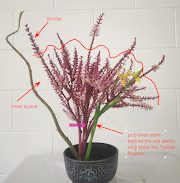Movement 2
Ikebana Aesthetics Program - Zoom Ikebana Dojo
Learn about the four Ikebana principles online in November & December 2020. Beginners welcome. 日本からのご参加歓迎いたします。
Video Tutorial: See top. Please follow our site or subscribe to our Youtube Channel.
When:
Group 1, 4:00 - 4:30 PM, 21 November 2020 (Melbourne Time)
Group 2, 4:00 - 4:30 PM, 28 November 2020 (Melbourne Time)
Group 3, 4:45 - 5:15 PM, 28 November 2020 (Melbourne Time)

Facilitators: Shoso Shimbo & Shoan Lo
Who can Join: Anyone, regardless of ikebana school, stage of learning or country of residence. Beginners welcome. You must be familiar with Zoom. Sessions will be conducted in English.
How Much: Aus $10 for one session. Pay by credit card through our new booking system.
Overview
Movement in ikebana
Movement is the way the elements such as shape or colour are organised to lead the eye to the focal area. We can create the path viewers’ eyes will travel and a feeling of motion.
In Movement 1 we looked at how a single S shape line represents movements of life energy. We also noted that a design framework of a classic Seika style consisting of three S shape lines.
In Movement 2 we will make a basic style that developed from the Seika style. All you have to do is following the diagram.
But be aware that you are practicing & learning;
- how to arrange 3 (at least 2) S shape lines in arrangement (angle, position, etc.),
- how to apply the Fibonacci numbers to the length of the 3 main lines (2 branches & 1 flower). See Session Notes - Movements 2.
Good branch materials suitable for basic style ikebana are often available in flower shops in Japan. But this is not the case in many parts of the world. Once you reach a certain level, you will enjoy working with almost any type of plant materials. But it is important for beginners to use “good” branch materials. Many beginners choose branch materials that are not suitable for the basic style. That is often a major reason why basic style arrangements by beginners are not poetic. Basic style arrangement can be poetic, and can be exhibition or commercial pieces.
Objectives in Movement 2
1. Become familiar with ikebana diagrams. See Session Notes - Movement 2.
2. Learn to use an irregular triangle as a design framework.
3. Find suitable branch materials. See Session Notes - Movement 2.
4. Learn how to emphasize movement in your basic style arrangement.
5. Advances students can include more than 3 S shape lines in your design and/or use more than 3 materials i.e. 1 branch material & 2 flower materials. Create your variation of a basic style.
What You Need
1. secateurs
2. kenzan or florist foam or wire packed container (see a task for Balance 1) for moribana style.
3. container - any include a cup.
4. flower materials:
- Lineal materials - Hydrangea
- Flowers - Stock
Flower materials are guide only. You can choose any other materials as long as you focus on the topic.
How to Make It?
You will receive Session Notes - Movement 2 with step-by-step instructions for making your arrangement after your payment is received. Our free video and the Session Notes will help you make your ikebana work.
How to Join
Step 1 - Book & Pay
(1) Book from our Booking Calendar. Pay by credit card.
(2) Upon receipt of your payment, our booking system will send you an email of invitation to the Zoom session.
Also you will receive session notes on how to make our sample work usually 5 days prior to the session.
Please visit our orientation page for more practical advice on how to use Ikebana Dojo.
Step 2 - Get Ready
(3) Do your assignment. Make your ikebana work before the session.
(4) Take a photo of your work (less than 0.5 Meg.) and send to ikebana.dojo@gmail.com at least 24 hours before the session starts if you want detailed feedback.
(5) Alternatively, you can share the photo of your work during the session. Find a way to share your file using Zoom.
Step 3 - Join Dojo
(6) Join the session. Prepare your work and its photo.
03:55 PM Australia/Melbourne: Please join the session, and check your connection etc.
04:00 PM Australia/Melbourne: Let’s start session together.
04:30 PM Australia/Melbourne: Session closes
(7) Enjoy show and tell by other students before and after your own presentation. Group interaction is helpful for your learning. Works by others can inspire you.
Step 4 - Rework
(8) Share a photo of your work to Ikebana Gallery Facebook Page. See how to apply for Ikebana Gallery Award if you are a student.
(9) If you would like to join Zoom Ikebana Dojo again, please visit our pages on Ikebana Aesthetics Program or Special Program. Register your email and follow our site to receive the latest updates.
Samples for Advanced Students
References
























